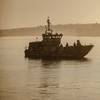IMO adopts Polar Code Safety Requirements
On November 21, the International Maritime Organization, or IMO, finalized the Polar Code and adopted amendments to the International Convention for the Safety of Life at Sea, or the SOLAS, which will create mandatory safety requirements for ships operating in Arctic and Antarctic waters.
These requirements, which are in addition to the standard SOLAS regulations, will enter into force starting January 1, 2017. When finalizing the Polar Code, the IMO made decisions on several key issues on the agenda at this session including: training, certification, navigation and operational assessments.
Training
The IMO considered ice navigation training for mariners based on the ice conditions in which a ship is operating. The IMO agreed that this training should be divided into basic and advanced ice navigation training. Operating in more severe ice conditions will require advanced training and IMO decided that advanced ice navigation certification will require sea service time for operating in ice. Recognizing that some ships make occasional voyages in polar waters, and the limited number of mariners who have operating experience in ice, the IMO drafted requirements to allow a person other than the ship’s crew to satisfy the advanced ice navigation training requirement. The IMO agreed that flexibility should be available to ship operators to achieve the required ice navigation training if acceptable to the ship’s flag Administration.
Certification
In the same context of ships making occasional voyages in polar waters, the IMO considered the Polar Ship Certificate requirements, noting that for some operations a ship’s equipment and structural design necessary to comply with existing SOLAS requirements may also satisfy the added provisions of the Polar Code. Therefore, for limited operations, a physical survey may not be necessary before issuing a Polar Ship Certificate. For these limited operations, compliance with the Polar Code may be demonstrated based on valid existing SOLAS certificates which cover the existing ship structure and existing equipment, noting that the ship must also comply with the additional operational measures and risk assessment required by the code.
Navigation and operational assessment
The IMO also agreed to specific requirements for on-board navigation and communications equipment. In addition, recommended guidance to use when conducting an operational risk assessment was included in the Polar Code and separate guidance for operational limitations in ice was considered. The latter guidance was not included in the Polar Code at this stage but will be further developed and considered as recommended guidance at the next Maritime Safety Committee meeting scheduled for June 2015.
The Polar Code also includes environmental requirements that amend the existing provisions under the International Convention for the Prevention of Pollution from Ships. These requirements are expected to be finalized and adopted by IMO in May 2015. If adopted in May, these provisions will also enter into force starting January 1, 2017. As amendments to existing provisions, the Polar Code will be implemented and enforced through the existing flag and port State authorities and programs.
See more at: http://mariners.coastguard.dodlive.mil/2014/12/08/1282014-imo-adopts-polar-code-safety-requirements/#sthash.zhrEs3Rt.dpuf
Written by Lt. Andrew Gibbons











